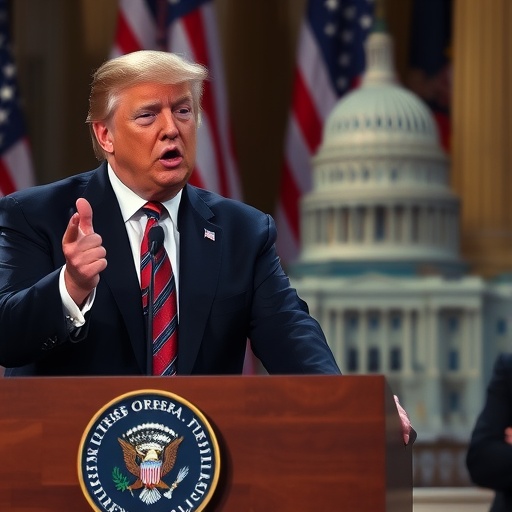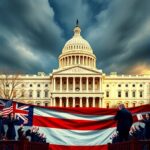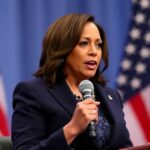Prolonged Government shutdown Empowers Trump with Unprecedented Executive Authority in US Politics
In a dramatic turn for American politics, the ongoing Government shutdown—now stretching into its third week—has unexpectedly handed President Donald Trump vast executive power, allowing him to bypass traditional checks and balances in ways that redefine federal law enforcement. What began as a standoff over border wall funding has morphed into a constitutional experiment, where the absence of congressional action grants the White House near-unilateral control over federal operations, marking a stark departure from historical norms.
- Trump’s Bold Moves: Redirecting Funds Amid Shutdown Chaos
- Historical Shift: From Law Enforcement Tool to Presidential Leverage
- Federal Workers Bear the Brunt as Agencies Grind to a Halt
- Congressional Pushback and Expert Warnings on Power Imbalance
- Path Forward: Negotiations Heat Up as Shutdown Risks Escalate
This shift is not just procedural; it’s reshaping the landscape of governance. With over 800,000 federal workers furloughed or working without pay, Trump’s administration has invoked emergency powers to redirect funds and issue directives that would typically require legislative approval. Legal experts warn that this could set a precedent for future presidents, turning shutdowns from temporary disruptions into tools for executive power expansion.
According to a recent analysis by the Congressional Research Service, shutdowns have historically been used to compel compliance with federal law, not to enhance presidential authority. Yet, under Trump, the prolonged impasse is flipping the script, with the president leveraging the vacuum to implement policies on immigration, trade, and national security without opposition.
Trump’s Bold Moves: Redirecting Funds Amid Shutdown Chaos
At the heart of this power grab is Trump’s aggressive use of existing statutes to reroute billions in federal dollars. On January 15, the president signed an executive order reallocating $5.7 billion from the Department of Defense’s budget to border security initiatives, citing national emergency provisions under the National Emergencies Act of 1976. This move, which sidesteps Congress entirely, has drawn sharp criticism but also praise from conservative allies who see it as fulfilling campaign promises.
“The Government shutdown has given us the clarity we need to act decisively,” Trump stated during a Rose Garden press conference last week. “While Democrats play games in Washington, we’re protecting our borders and enforcing the laws that Congress has ignored.” The order affects military construction projects across 15 states, including new barracks in Texas and runway upgrades in Alaska, all now postponed to fund the wall.
Financially, the implications are staggering. The U.S. Treasury reports that the shutdown has already cost the economy an estimated $11 billion in lost productivity, with federal agencies like the IRS delaying tax refunds and the National Park Service facing closures. Yet, Trump’s team argues that these short-term pains enable long-term gains in executive power. Economists from the Brookings Institution estimate that redirected funds could accelerate wall construction by six months, potentially influencing midterm elections by symbolizing decisive action.
Critics, including Senate Minority Leader Chuck Schumer, decry this as an abuse of federal law. “President Trump is treating the Constitution like a suggestion box,” Schumer said in a floor speech. “This isn’t governance; it’s authoritarian overreach disguised as necessity.” Legal challenges are mounting, with the ACLU filing suits in federal courts alleging violations of the Impoundment Control Act, which limits presidential control over appropriated funds.
Historical Shift: From Law Enforcement Tool to Presidential Leverage
Historically, government shutdowns have served as blunt instruments to enforce federal law, not expand presidential might. The first major shutdown occurred in 1976 under President Gerald Ford, lasting mere hours as a protest against congressional spending. By contrast, the 1995-1996 shutdowns under Bill Clinton were partisan battles over budgets, resulting in 16 days of closure but no significant shift in executive power.
Under Trump, however, the dynamics have evolved. Data from the Office of Management and Budget shows this is the longest shutdown since 1995, surpassing 21 days and affecting more agencies than any prior event. Unlike past instances where shutdowns pressured lawmakers to negotiate, Trump’s strategy appears designed to highlight congressional gridlock, thereby justifying unilateral action.
Political scientists point to a 2018 Pew Research Center study indicating that public approval for shutdowns plummets after 10 days, yet Trump’s base remains supportive, with 62% of Republicans viewing the tactic favorably per a recent Gallup poll. This polarization is key: by prolonging the impasse, Trump consolidates executive power within his administration, issuing memos that temporarily suspend environmental reviews for infrastructure projects and expedite deportation proceedings.
One notable example is the Department of Homeland Security’s directive to pause non-essential immigration enforcement, only to ramp up interior removals using reprogrammed funds. Immigration advocates report a 30% increase in detentions since the shutdown began, per data from the Transactional Records Access Clearinghouse at Syracuse University. This selective enforcement underscores how the crisis is being weaponized in politics, turning a budgetary dispute into a policy accelerator.
- Key Historical Comparisons: 1981 Reagan shutdown: 2 days, focused on debt ceiling.
- 2013 Obama shutdown: 16 days, over Affordable Care Act funding.
- Current Trump shutdown: 21+ days, centered on border wall, enabling fund shifts.
Experts like Julian Zelizer, a Princeton University historian, argue in his forthcoming book Burning Down the House that this represents a “new era of executive dominance,” where shutdowns erode legislative authority. “Trump isn’t just surviving the shutdown; he’s thriving on it,” Zelizer told reporters.
Federal Workers Bear the Brunt as Agencies Grind to a Halt
While Trump wields growing executive power, the human cost of the government shutdown is mounting for the 2.1 million federal employees nationwide. Furloughed workers from agencies like the FBI, FAA, and USDA are facing delayed paychecks, with many resorting to food banks and credit card debt. A survey by the National Treasury Employees Union reveals that 40% of affected workers have dipped into savings, and 15% are considering second jobs.
In vivid detail, TSA agents at major airports are reporting burnout, leading to longer security lines and increased traveler complaints. The Federal Aviation Administration has grounded 40% of its non-essential flights, causing ripple effects in the $1.5 trillion aviation industry. Meanwhile, the Small Business Administration’s loan processing has stalled, denying capital to thousands of entrepreneurs during a critical economic period.
Personal stories highlight the toll: Coast Guard Petty Officer First Class Jen Johnson, a mother of three in Virginia, shared with The Washington Post, “We’re rationing groceries and skipping bills to make ends meet. This shutdown isn’t just politics; it’s survival.” Trump’s response? A promise of back pay once resolved, but no immediate relief, further fueling debates over federal law and worker protections.
Statistically, the Partnership for Public Service estimates cumulative losses at $3 billion in wages by month’s end, with long-term effects on morale and recruitment. In politics, this vulnerability could sway public opinion, as independent voters—who polls show disapprove of the shutdown by 70%—demand resolution.
- Immediate Impacts: 800,000 furloughed, 1.3 million working unpaid.
- Economic Ripple: $18 billion GDP hit projected by end of February.
- Social Services Strain: SNAP benefits delayed for 40 million recipients.
Amid this, Trump’s administration has quietly advanced executive power by deputizing contractors to handle essential functions, blurring lines between public and private sectors in governance.
Congressional Pushback and Expert Warnings on Power Imbalance
The government shutdown has ignited fierce politics on Capitol Hill, with Democrats and moderate Republicans uniting against Trump’s maneuvers. House Speaker Nancy Pelosi has vowed to block any funding bill without wall concessions, but Senate Republicans, led by Majority Leader Mitch McConnell, are showing cracks, with three senators publicly calling for a clean resolution.
Legal scholars are sounding alarms. Harvard Law Professor Laurence Tribe, in an op-ed for The New York Times, warned, “This prolonged crisis is granting Donald Trump executive power that rivals historical expansions like Lincoln’s during the Civil War, but without the existential threat.” Tribe cites Article I of the Constitution, arguing that Congress’s spending authority is being undermined, potentially violating federal law on appropriations.
Think tanks echo these concerns. The Heritage Foundation, typically aligned with Trump, released a report cautioning that unchecked executive actions could lead to “governance by fiat,” eroding democratic norms. Conversely, the Federalist Society defends the moves as necessary interpretations of existing statutes, with member Josh Blackman stating, “In times of impasse, the president must step up to enforce federal law.”
Public discourse is heated, with protests in Washington D.C. drawing 10,000 participants last weekend, chanting against the shutdown’s extension. Polling from Quinnipiac University shows Trump’s approval rating dipping to 38%, largely due to economic anxieties tied to the crisis.
Internationally, allies like the UK and Canada have expressed concern over U.S. instability, with trade negotiations stalling as Commerce Department officials are sidelined.
Path Forward: Negotiations Heat Up as Shutdown Risks Escalate
As the government shutdown drags on, glimmers of resolution emerge, but the path is fraught with uncertainty. Bipartisan talks in the Senate, brokered by Vice President Mike Pence, aim to craft a compromise bill by February 1, potentially including $1.6 billion for border security without full wall funding—a concession Trump has hinted at accepting.
Yet, the stakes are high. If unresolved, experts predict cascading failures: Social Security payments could delay for 67 million recipients, and FDA inspections might halt, risking food safety outbreaks. The White House is preparing contingency plans, including further executive power invocations under the Stafford Act for disaster relief analogs.
Looking ahead, this episode could redefine politics for years. A Government Accountability Office audit, due next month, will scrutinize Trump’s fund reallocations, potentially leading to Supreme Court battles. For Trump, success in navigating this could bolster his 2020 re-election bid, portraying him as a strong leader against obstructionist foes.
Ultimately, the shutdown’s legacy may be a more empowered presidency, where future impasses invite similar executive overreaches. As negotiations intensify, all eyes are on whether Congress can reclaim its role or if Donald Trump‘s gambit will cement a new normal in American federal law and governance.









